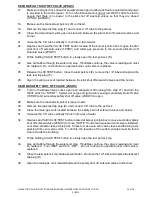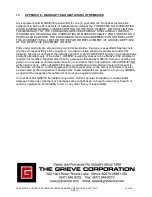
W:\ELECTRICAL\INSTRUCT\FURNACE\FURNACE GENERAL INSTRUCTIONS 2011.DOC
21 of 36
01/2014
1) Use a NIOSH approved respirator.
2) Use goggles or safety glasses with side shields
3) Use leather gloves, long-sleeved and long-legged, loose fitting
clothing.
4) Handle materials in a manner that will create the least amount of
dust.
5) Consult the MSDS information on the materials involved included
elsewhere in this manual.
7-8.4 Duct Work
7-8.4.1
It is important furnace ducts be kept clean. If they are subjected to a build-up
of flammable deposits of condensed solvent, oil vapors, dust or other
combustible debris they must be periodically cleaned. The build-up of
condensed vapors or combustible debris is a major cause of fires. Cleaning
frequency should be determined by furnace process requirements.
7-8.5 Lubrication
7-8.5.1
Electric motors having oil holes require lubrication after every 25,000 hours or
3 years of light duty operation. Use a good grade of SAE 10 electric motor oil
or as recommended by the manufacturer of the motor. Larger motors in the
integral horse power range, which require grease, should be greased every six
(6) months or more frequently where the severity of the service would dictate.
No special heat resistant grease is necessary.
7-8.5.2
All bearings, including those on blowers, exhauster or conveyor system,
should be greased every six (6) months or 500 hours of operation with a good
grade of machine grease. No special heat resistant grease is necessary.
7-8.6 Doors/Gaskets
7-8.6.1
The furnace door should be inspected regularly to see that it is being held
firmly and uniformly against the furnace front plate providing a maximum
sealing force. Slots in the mounting brackets and/or adjusting screws are
available for this purpose. NOTICE: Before attempting these adjustments, be
sure the furnace is level. If the furnace is not on a solid level base, it could
twist out of square resulting in a poor seal, which cannot be corrected by an
adjustment.
7-8.6.2
The door should be inspected for damage which would allow excessive
leakage of hot air. The gasket (if so equipped) or door seal should be
replaced when damaged or when an adequate seal cannot be maintained.
7-8.7 Blowers and Exhausters
7-8.7.1
Tighten set screws between bearings and shaft before operating and check
periodically. Loose bearings will allow shaft movement resulting in wear to the
shaft within the bearing race. Set screws on blower wheels must also be
checked and tightened.
7-8.7.2
Recirculation and exhaust blowers that are V-belt driven shall be checked for
sheave alignment to prevent excessive belt wear and to make sure belts are
not slipping.














































